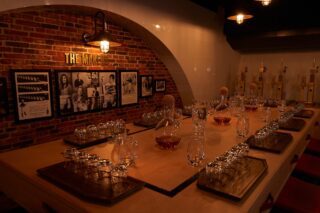This website uses cookies so that we can provide you with the best user experience possible. Cookie information is stored in your browser and performs functions such as recognising you when you return to our website and helping our team to understand which sections of the website you find most interesting and useful.
Culture of Contrasts: from multicultural Lima to the heights of Machu Picchu
By Gabriel Power | 20 June 2023 | Culture, Food & Drink, Lifestyle, Travel
From the culinary delights of multicultural Lima to the dizzying heights of Machu Picchu, we explore the dramatic landscapes of Peru
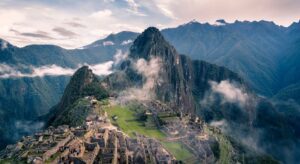
Machu Picchu, Peru
Standing amid the pre-Incan salt mines of Maras, had you told me that the mountains ahead of me delineating the boundaries of the Sacred Valley were constructed from matcha, I might well have believed you. Here, in the death throes of the dry season, the impressive peaks have gone upwards of six months without rain and now visibly beg for water; their usually lush, verdant vegetation has taken on a dusty quality that looks like it would come off on the fingers of the gods in a fine powder, were they to reach down and touch.
It’s my ninth day in Peru and I’m stranded at the crossroads of exhaustion and exhilaration. By the time my guide Gina and I reached this unique vantage point overlooking the Sacred Valley, in which a large chunk of the famed Inca Trail sits, we have covered a remarkable amount of ground across the Andean highlands of Peru. Forming an idiosyncratic yet inseparable trio with our driver Jesus, we’ve trekked around the eerily circular Incan ruins of Moray, sipped coca tea to stave off altitude sickness in the markets of Cusco, and we’ve scaled the mighty Machu Picchu, the mountain upon which the iconic citadel of the same name is perched.
This enormous country – the 19th largest on Earth – is a Pollock painting of unforgiving terrain. A streak of ultra-high-altitude Andean peaks runs down the centre, flanked by uninhabited cloud forests and dense jungles to the east while, to the west, one of the world’s driest deserts encompasses much of the nation’s Pacific coast and capital city, Lima.
Peru had, in my mind at least, always seemed a destination designed for hardcore outdoor types; those unflustered by the extremes of the natural world. But I had arrived on Peruvian shores with the aim of investigating the prospect of this country as a high-end luxury destination, completely unaware of the ease with which this angle could be sold.
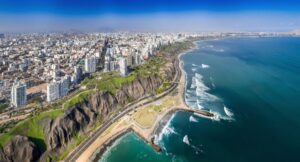
Peru’s capital, Lima
I began my adventure in Lima. Admittedly, I knew nothing of Peru’s capital city at first, so underrepresented is it within contemporary travel journalism, and I was so apprehensive about my impending travels to the punishing altitudes of Cusco and the Sacred Valley that I initially let much of it slip by. But, from the window of my 23rd-floor room at the five-star Marriott that first evening, this 11-million-strong city became an ocean of spirited nightlife as twilight took hold. I had to get down there.
I made my way through the upmarket Miraflores and Barranco districts as night fell, and by the time I had reached the Parque 7 de Junio, the city had erupted into life, the bustle galvanised by a prominent al fresco food tradition gifted to the city by its extremely scarce rainfall — often as little as 6mm per year. It was here in Miraflores, long before I had reached the natural beauty of the Sacred Valley, that I discovered what should be one of Peru’s biggest drawing points: its frankly stunning food.
Peruvian fare is one of the most unusual national cuisines to be found anywhere on the planet. Where many cultures are fiercely protective of their culinary traditions, from ingredients to preparation processes, Peru has effectively invited the world into its kitchen; even the most beloved national dishes borrow ingredients and cooking techniques from their sizeable immigrant communities in a manner that reflects a historically rather harmonious multiculturalism.
The result is deliciously peculiar. Starting at iconic Miraflores eatery Panchita, I sampled the classic lomo saltado (below), a national favourite featuring typically Peruvian ingredients of beef, onions and potatoes, but stir-fried and served swimming in a reduction containing a significant helping of soy sauce. This Peruvian-Chinese hybrid cuisine even has its own name – Chifa – with entire restaurants dedicated to its dishes. Meanwhile, Nikkei is the name bestowed upon a similar melding of Peruvian and Japanese culinary stylings, which I gorged on in the form of deep-fried squid and rice at the hidden gem Lobo de Otani. But my gastronomic journey truly peaked when I pivoted toward the more purist Peruvian offerings available, heading to famed joint AlFresco and opting for a cilantro trout ceviche so immaculate I had to stop myself from bursting into song in the restaurant’s garden.
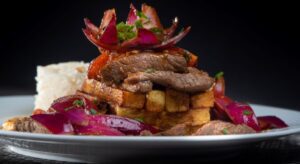
lomo saltado, a national favourite in Peru
HISTORY AT ITS PEAK
If travelling from far afield as Europe, taking in Cusco, Machu Picchu and the Sacred Valley necessitates a trip of two deeply contrasting halves. Departing Lima, I left in my wake a ruthlessly cosmopolitan city; during the day gently bubbling with an energy that goes critical after sundown, its cultured nightlife coaxing out snappily dressed teenagers, boisterous young professionals and 15-strong extended families in equal measure.
But to arrive in Cusco an hour or so later is to gate-crash the crescendo of colonialism’s great unfinished symphony. Not purely of Conquistador heritage, nor serving as a purist bastion of the Quechuan culture which came before, this ultra-high-altitude city is a perplexing and charming blend of the two, exemplified in everything from the street food to the religious architecture. Every street in the Old Town, for instance, is lined with gorgeous 16th-century Spanish townhouses, still proudly displaying the ancient Incan granite foundations on which they were built.
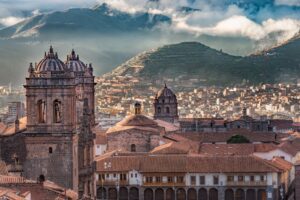
Cusco, Peru
Cusco sits at 3,400m above sea level; compared to sea-level Lima, the oxygen is perceptively thinner, the atmosphere drier and the sunshine more brutal. Without an adequate rest period or supplemental oxygen, remaining at this altitude is considered hazardous enough that a whistlestop tour of San Pedro Market was immediately followed by a 50km drive across the Altiplano Plateau and down to Urubamba, in the deepest crevice of the Sacred Valley, where I would stay at 2,900m for three full nights to acclimatise.
Urubamba is simply wonderful. In the shadow of the frightening Chicón Mountain and its murky blue-grey glacier, I wandered its narrow-gridded streets upon arrival, sampling coca and muña teas as I weaved in and out of antique and souvenir shops, brushing alpaca wool table runners and Inka Cola-branded hoodies from my sunburnt face as I went. In the evening I returned to the main square, knocked a few IPAs back at the genuinely remarkable Cerveza Willkamayu – a stunning microbrewery housed in a colonial-era family home and only accessible via a secret doorbell – before heading to Tambo del Inka, one of the finest hotels in Peru.

Urubamba, Peru
After checking in in the cavernous black-stone lobby, I sidled open the door to my room and was greeted with the extraordinary sight of an enormous room with two king size beds, a walk-in closet and a balcony with a private view over the Vilcanota River, the Sacred Valley’s lifeforce. Days could have gone by on that balcony and I wouldn’t have noticed; the trickling water of the river simply washed time away with it, whether I was languishing in the morning sun or stargazing at night, failing to recognise any of the Southern Hemisphere’s constellations. Those without private balconies could still do the same in the resort’s heated outdoor pool.
At the on-site Hawa Restaurant, I got the chance to try everything from tender alpaca meat to the rather more acquired taste of guinea pig, before the start of what would be an epic trip to Machu Picchu by train. We drove to the nearby town of Ollantaytambo – itself known for an Incan archaeological site that would be globally famous were it not just up the road from one of the Seven Wonders of the World – and boarded the PeruRail service which would slowly snake out of the lowest extremity of the Sacred Valley and toward the fog-laden cloud forests of Machu Picchu.
This journey alone is spectacular enough to warrant the trip from London. The mountain peaks rose higher and higher as we descended through the valley and away from civilisation, the parched grass of the highlands giving way to something akin to Jurassic World, dense with tropical foliage dripping with weeks’ worth of rainfall. The contrast from dusty Ollantaytambo seemed impossibly stark; as we pulled into Aguas Calientes, the final town on the Inca Trail and the gateway to Machu Picchu, it felt like we had traversed half the globe, and now disembarked in what was effectively a jungle. Monkeys scuttled about in an undergrowth punctuated by electrifying orchids as waterfalls overflowed with briny mineral water.
At 5am the next morning I rose from my bed at Inkaterra Machu Picchu Pueblo, one of the more luxurious hotels in Aguas Calientes, ready to finish our journey by bus and on foot. Gina and I climbed step after treacherous step until she told me to stop at a seemingly peculiar spot. As we waited on what looked like the edge of a cliff, staring blankly into an entirely opaque cloud. Suddenly, the clouds tore apart, stretching and breaking up like cobweb caught on the mountain, revealing the great Machu Picchu in a manner in which I will never forget; silently perched atop an angular peak as it had done for 600 years, jutting out from an impossibly deep sea of shifting, stirring clouds. The scene was both intensely kinetic and serenely static. It was eerily, agonisingly beautiful.
Peru could scarcely have offered a more generous parting gift. I realised the whole trip had been one big life-affirming journey. Every day I had spent in this country had offered me at least one moment that gave me chills, borne of a strikingly wide range of scenarios – be it the grandiosity of the pre-Incan ruins of Huaca Pucllana temple or the honestly life-changing tiradito I ate in a Cusco Nikkei restaurant.
A maelstrom of contrasting landscapes and cultures, Peru is a country without equal; an implausibly perfect holiday destination that would leave even the most seasoned traveller’s head spinning. This sleeping giant of South America, simply by being its extraordinary self, is demanding not to be missed.
Read more luxury travel stories with Tempus’ reviews






